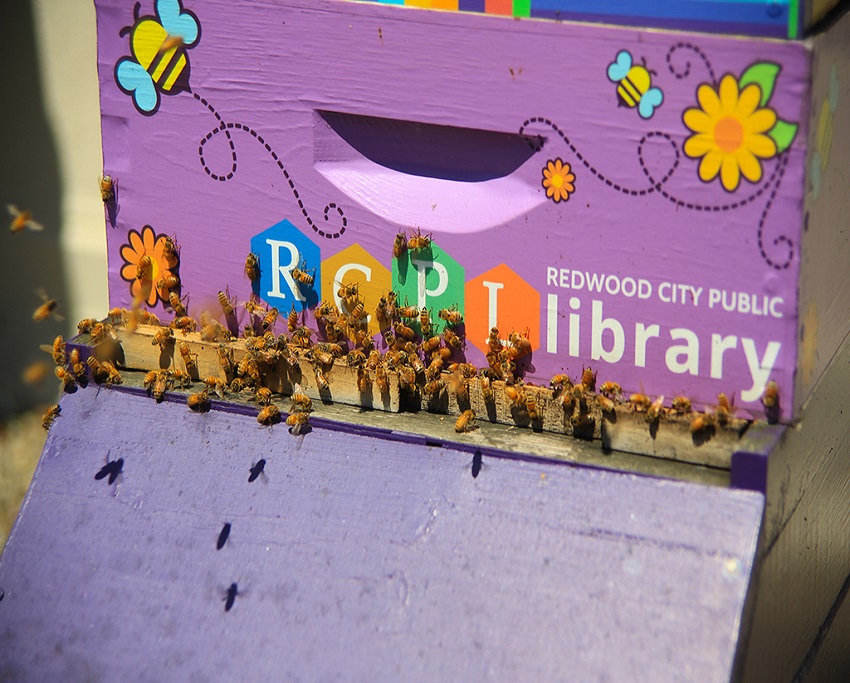Honey…it’s kind of an unsung hero of the pantry, isn’t it? If you’re not a floral- or spice-note seeking connoisseur (which I cannot claim to be) it’s just kind of…there. A half-filled, slightly crystalized bear lurking at the back of the shelf waiting to be called into action.
But connoisseur or not, there is a new reason to get excited about honey: The Redwood City Public Library team is harvesting and selling sweet, golden nectar. The honey is sourced from the two cheerfully painted bee boxes that have been fixtures on the library rooftop since early 2018. Last year’s one and only harvest sold out within thirty minutes.
But fear not, because this year the harvest is much more plentiful. Library Director Derek Wolfrgam, who helped found the bee program with Parks, Recreation and Community Services Director Chris Beth, says that over the fall it’s expected that anywhere from 75 to 100 pounds of honey will be collected, plenty to keep the shelves stocked. The exact date this month that the honey will be available on the shelves of the Friends of the Library Bookstore (in the lobby of the library at 1044 Middlefield Road) was not available at the time of printing but will be announced on the Redwood City Public Library Bees Facebook page (https://www.facebook.com/rcplbees/).
Whenever it hits the shelves, this year’s bounty is a welcomed victory for the bee program: Shortly after last summer’s smaller harvest, the hives were struck by a common bee-killing mite. Sadly, there were no survivors.
“We lost all of them,” said Wolfgram, shaking his head. Though the initial setback was discouraging, he and the program’s partner, local beekeeper Kendal Sager, did not give up. Sager brought in new baby bees, and today the hives are estimated to be 110,000 bees-strong.
The strength of the beehives and all that honey-making offers a taste into the fascinating world of bees: The honey harvested in July and August is going to taste different from the honey harvested later in the fall. As Wolfgram explains it, this is because the first round of honey collected was made from springtime flowers, in particular, fennel. This will give the honey stronger, spicier notes. The later harvest will be made from summer flowers and is expected to have a sweeter, more floral taste.
A six-ounce jar costs $10. The proceeds go back into the library and are used to support children’s activities and educational programs like the Summer Learning Challenge. But it wouldn’t be a library program without an educational angle, would it? In addition to the hives on the rooftop, there’s a Bee Interpretive Center in the library’s children’s section. This is where the bee-curious, young and old, can learn more about the fascinating lives of bees, including their environmental importance and how to do the bees’ figure-eight “bee waggle” dance. There is even a solar-powered, livestream video of beehive activity.
“This is just such a unique and engaging way to learn. A way for us to create new experience that they wouldn’t expect at the public library,” Wolfgram said. He’s not the only one who thinks so. The program has caught the attention of state and national library associations. This fall, Wolfgram, Sager, and Library Supervisor Jenny Barnes have been invited to “spread the gospel of the bees” as Wolfgram puts it, at the California Library Association’s annual conference in October. The theme? A League of Extraordinary Librarians.
But the question for some (or many) may still remain: What does one do with honey, other than drizzle it over a scone or peanut butter toast (both delicious options, by the way)?
For those looking for something a little more exciting than a drizzle but still quick and easy, go for honey butter. Just mix ¾ cup of room-temperature butter with ¼ cup honey until completely combined. You’re of course welcome to play with ratios to make it more or less sweet. Alton Brown adds vanilla and cinnamon, but you don’t have to (I don’t). This is one of my favorite honey hacks because whether it be served at brunch, lunch or dinner, honey butter always takes cornbread muffins, buttermilk biscuits, and yes, scones, to new heights.
Alternatively, make this recipe for honey and mustard-glazed carrots. It comes from one of my favorite cookbooks — and is a reminder that honey plays nicely with the savory. Whether you go for the butter, the carrots, or just Google “honey cake” (seriously, there are so, so many recipes) you can’t go wrong. Bring some honeyed delight to your table this fall, and when your guests ask where your delicious, floral-noted nectar came from, make sure you send them to the library.
Glazed Carrots with Mustard and Honey
Vegetarian Cooking for Everyone, by Deborah Madison
These glazed carrots come together so quickly, they’re perfect for weekday meals and dinner parties alike. I think for a dinner party though I might not cut them as short and use rainbow-colored carrots — just to add some color and pizazz to the plate. Post carrot photoshoot, I put mine on a pile of spinach, sprinkled it all with a hearty dose of feta cheese, and it made for quite the lovely, late-night dinner (if I do say so myself).
1 ½ pounds carrots, scrubbed or peeled
1 tablespoon butter
1 tablespoon honey
2 teaspoons Dijon mustard
Salt and freshly milled pepper
Chopped parsley
Cut the carrots into 3-inch lengths; halve or quarter the thicker ends so they cook evenly. Steam or boil until tender.
In a medium skillet, melt the butter with the honey, then stir in the mustard and carrots and season with salt and plenty of pepper. Cook over medium heat for several minutes, until well-coated and bubbling, then toss with chopped parsley and serve.
This story was originally published in the September print edition of Climate Magazine.






